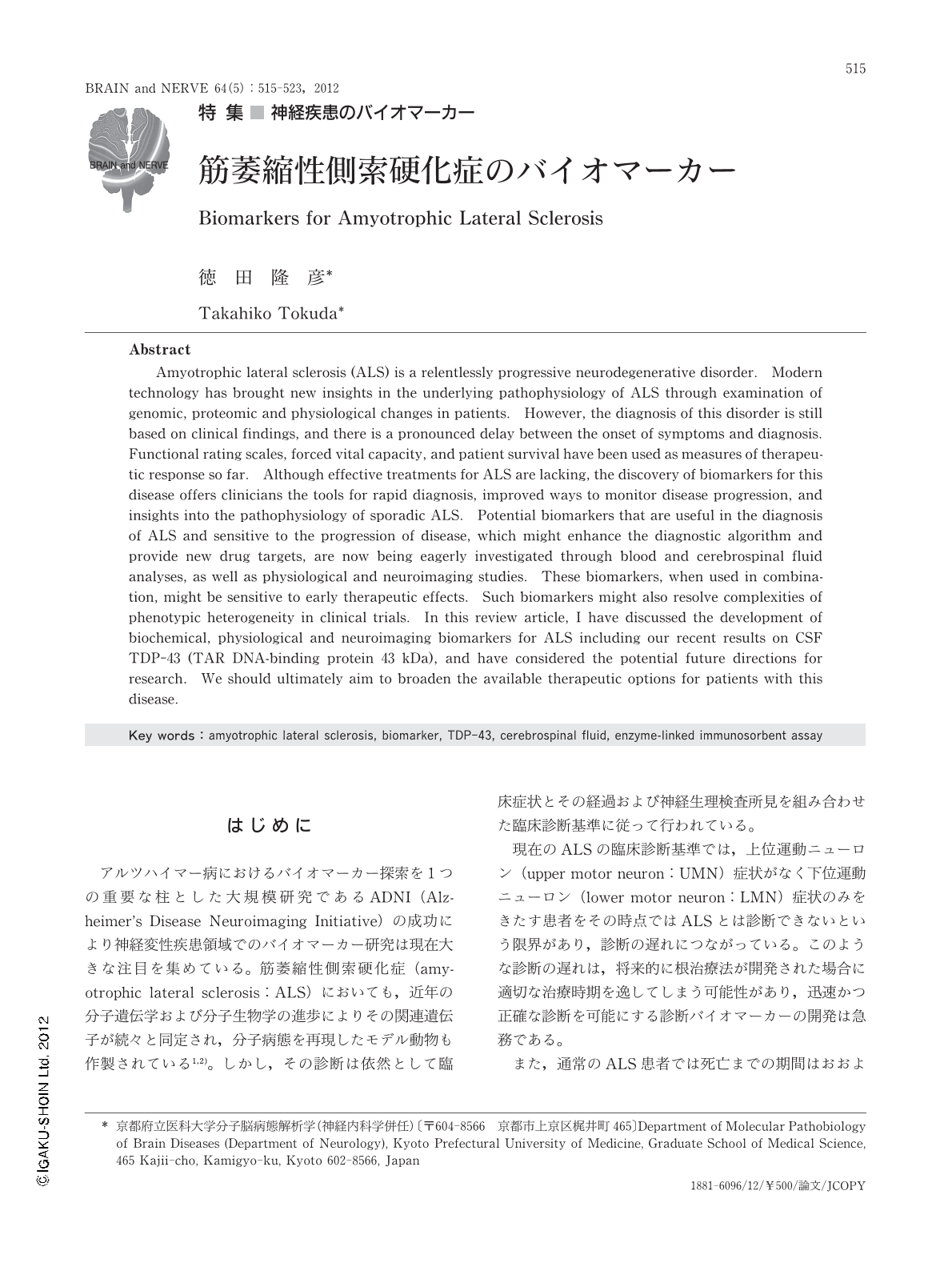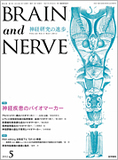Japanese
English
- 有料閲覧
- Abstract 文献概要
- 1ページ目 Look Inside
- 参考文献 Reference
はじめに
アルツハイマー病におけるバイオマーカー探索を1つの重要な柱とした大規模研究であるADNI(Alzheimer's Disease Neuroimaging Initiative)の成功により神経変性疾患領域でのバイオマーカー研究は現在大きな注目を集めている。筋萎縮性側索硬化症(amyotrophic lateral sclerosis:ALS)においても,近年の分子遺伝学および分子生物学の進歩によりその関連遺伝子が続々と同定され,分子病態を再現したモデル動物も作製されている1,2)。しかし,その診断は依然として臨床症状とその経過および神経生理検査所見を組み合わせた臨床診断基準に従って行われている。
現在のALSの臨床診断基準では,上位運動ニューロン(upper motor neuron:UMN)症状がなく下位運動ニューロン(lower motor neuron:LMN)症状のみをきたす患者をその時点ではALSとは診断できないという限界があり,診断の遅れにつながっている。このような診断の遅れは,将来的に根治療法が開発された場合に適切な治療時期を逸してしまう可能性があり,迅速かつ正確な診断を可能にする診断バイオマーカーの開発は急務である。
また,通常のALS患者では死亡までの期間はおおよそ2~5年であるが,約10%の患者は診断後10年以上の経過をたどる例も存在することが知られており3,4),症状の進行速度あるいは予後を判定するバイオマーカーがあれば,ケアプランの作成などの臨床的な場面以外に,薬剤の臨床治験における対象患者の正確な層別化および治療効果の判定にも有用であると考えられる。
以上のように,ALSの臨床・治療開発研究においては,特に早期診断に有用な診断バイオマーカーおよび疾患の進行速度すなわち病勢の強さを判定する重症度判定バイオマーカーの開発が強く求められている。
では,バイオマーカーとは具体的にどのようなものを指すのであろうか。広い意味でのバイオマーカーはTable1のように定義され,その様式としては生理学的検査,画像検査,遺伝子検査,生化学的検査(狭義のバイオマーカー=生化学的バイオマーカー)などが考えられる。さらに,バイオマーカーに求められる条件については,アルツハイマー病における「理想的な診断バイオマーカーの条件」がよくまとまっている(Table2)5)。
このような条件の中でも,(1)にある,「神経病理の本質的な特徴を検出できること」という項目が重要であると考えられる。近年のプロテオミクス(proteomics)の進歩によってヒトの体液中に多数のバイオマーカー候補蛋白が同定されているが,それらの蛋白分子がその疾患の神経病理とどのような関連を有するかは必ずしも明らかではない。このように,上記(1)の条件を満たさないバイオマーカーは,再現性が低いあるいはその疾患に対する特異度が低い可能性がある。ただ,神経変性疾患のバイオマーカー研究は発展途上であり,新規に同定された疾患関連蛋白がこれまでは明らかではなかった分子病態を解明する手がかりとなる場合もある。
本稿では,これまでに検討されてきたALSのバイオマーカーについて,生化学的バイオマーカー(狭義のバイオマーカー)を中心に,また,生理学的および画像診断バイオマーカーも含めて概説したい。
Abstract
Amyotrophic lateral sclerosis (ALS) is a relentlessly progressive neurodegenerative disorder. Modern technology has brought new insights in the underlying pathophysiology of ALS through examination of genomic,proteomic and physiological changes in patients. However,the diagnosis of this disorder is still based on clinical findings,and there is a pronounced delay between the onset of symptoms and diagnosis. Functional rating scales,forced vital capacity,and patient survival have been used as measures of therapeutic response so far. Although effective treatments for ALS are lacking,the discovery of biomarkers for this disease offers clinicians the tools for rapid diagnosis,improved ways to monitor disease progression,and insights into the pathophysiology of sporadic ALS. Potential biomarkers that are useful in the diagnosis of ALS and sensitive to the progression of disease,which might enhance the diagnostic algorithm and provide new drug targets,are now being eagerly investigated through blood and cerebrospinal fluid analyses,as well as physiological and neuroimaging studies. These biomarkers,when used in combination,might be sensitive to early therapeutic effects. Such biomarkers might also resolve complexities of phenotypic heterogeneity in clinical trials. In this review article,I have discussed the development of biochemical,physiological and neuroimaging biomarkers for ALS including our recent results on CSF TDP-43 (TAR DNA-binding protein 43 kDa),and have considered the potential future directions for research. We should ultimately aim to broaden the available therapeutic options for patients with this disease.

Copyright © 2012, Igaku-Shoin Ltd. All rights reserved.


